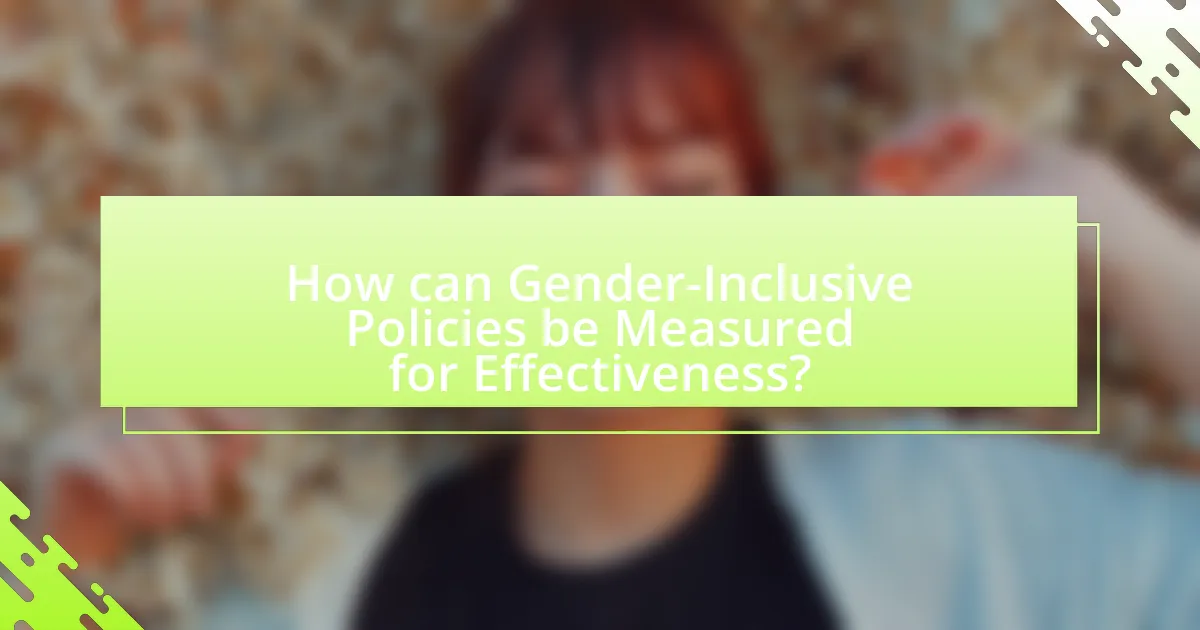Gender-inclusive policies are essential frameworks aimed at ensuring equal opportunities and rights for individuals of all genders, addressing systemic inequalities and fostering inclusivity. These policies significantly enhance life quality globally by improving access to education, healthcare, and employment, which in turn drives economic growth and social stability. The article explores the impact of gender-inclusive policies on various aspects of life quality, the importance of implementing such policies, the challenges faced in their execution, and the best practices for fostering inclusivity. It emphasizes the economic benefits of gender equality, highlighting that closing gender gaps could add trillions to global GDP, while also discussing the role of education and data collection in promoting effective policy outcomes.

What are Gender-Inclusive Policies and Why are They Important?
Gender-inclusive policies are frameworks and practices designed to ensure equal opportunities and rights for individuals of all genders, addressing systemic inequalities and promoting inclusivity. These policies are important because they contribute to social equity, enhance economic growth, and improve overall quality of life. For instance, research by McKinsey & Company indicates that gender-diverse companies are 21% more likely to outperform their counterparts in profitability. Furthermore, the World Economic Forum’s Global Gender Gap Report highlights that closing gender gaps in labor force participation could add $28 trillion to global GDP by 2025. Thus, implementing gender-inclusive policies not only fosters fairness but also drives economic and social progress.
How do Gender-Inclusive Policies impact life quality globally?
Gender-inclusive policies significantly enhance life quality globally by promoting equality and reducing discrimination. These policies lead to improved access to education, healthcare, and employment opportunities for all genders, which in turn fosters economic growth and social stability. For instance, the McKinsey Global Institute reported that closing gender gaps in labor force participation could add $12 trillion to global GDP by 2025. Furthermore, countries with gender-inclusive policies often experience lower rates of violence and higher levels of civic engagement, contributing to overall societal well-being.
What specific aspects of life quality are enhanced by these policies?
Gender-inclusive policies enhance various aspects of life quality, including economic stability, health outcomes, and social equity. These policies promote equal access to education and employment opportunities, which leads to increased income levels and reduced poverty rates. For instance, the McKinsey Global Institute reported that closing gender gaps in labor force participation could add $28 trillion to global GDP by 2025. Additionally, gender-inclusive healthcare policies improve maternal and reproductive health, resulting in lower mortality rates and better overall health for families. Furthermore, such policies foster social equity by challenging discriminatory practices, thereby creating more inclusive communities.
How do these policies address inequalities in different regions?
Gender-inclusive policies address inequalities in different regions by promoting equitable access to resources, opportunities, and decision-making processes for all genders. These policies often include measures such as targeted educational programs, healthcare access improvements, and economic empowerment initiatives that specifically aim to uplift marginalized groups. For instance, the implementation of gender quotas in political representation has been shown to increase women’s participation in governance, leading to more inclusive policy-making that reflects the needs of diverse populations. Additionally, research indicates that countries with gender-inclusive policies experience higher economic growth rates, as seen in the World Economic Forum’s Global Gender Gap Report, which highlights the correlation between gender equality and overall societal advancement.
Why is it crucial to implement Gender-Inclusive Policies?
Implementing gender-inclusive policies is crucial because they promote equality and enhance the quality of life for all individuals. These policies address systemic disparities, ensuring equal access to resources, opportunities, and rights regardless of gender. Research indicates that countries with gender-inclusive policies experience higher economic growth; for instance, McKinsey Global Institute reported that closing gender gaps in labor force participation could add $28 trillion to global GDP by 2025. Furthermore, gender-inclusive policies contribute to improved health outcomes and educational attainment, fostering a more equitable society.
What are the potential consequences of neglecting gender inclusivity?
Neglecting gender inclusivity can lead to significant social and economic consequences. Organizations and societies that fail to embrace gender inclusivity often experience decreased productivity, as diverse teams have been shown to outperform homogeneous ones by up to 35% in terms of innovation and problem-solving capabilities. Furthermore, neglecting gender inclusivity can perpetuate systemic inequalities, resulting in a lack of representation in leadership roles, which can hinder decision-making processes and limit diverse perspectives. This lack of representation can also contribute to higher rates of gender-based violence and discrimination, as marginalized voices remain unheard. According to the McKinsey Global Institute, closing gender gaps in labor force participation could add $28 trillion to global GDP by 2025, highlighting the economic cost of neglecting gender inclusivity.
How do these policies contribute to sustainable development goals?
Gender-inclusive policies contribute to sustainable development goals by promoting equality and empowering women, which directly supports Goal 5: Gender Equality. These policies enhance women’s access to education, healthcare, and economic opportunities, leading to improved social and economic outcomes. For instance, research shows that increasing women’s participation in the workforce can boost GDP by up to 35% in some countries, demonstrating a clear link between gender inclusivity and economic growth. Additionally, gender-inclusive policies foster healthier communities, as empowered women are more likely to invest in their families’ health and education, aligning with Goals 3: Good Health and Well-Being and 4: Quality Education.

What are the Key Components of Effective Gender-Inclusive Policies?
Key components of effective gender-inclusive policies include comprehensive legal frameworks, equitable access to resources, gender-sensitive budgeting, and active participation of diverse gender groups in decision-making processes. Comprehensive legal frameworks establish protections against discrimination and promote equal rights, as seen in countries with strong gender equality laws, which correlate with improved social outcomes. Equitable access to resources ensures that all genders can access education, healthcare, and economic opportunities, leading to enhanced quality of life. Gender-sensitive budgeting allocates funds to initiatives that address specific needs of different genders, thereby promoting fairness and inclusivity. Finally, active participation of diverse gender groups in decision-making processes fosters representation and ensures that policies reflect the needs of the entire population, contributing to more effective governance and social cohesion.
What strategies can be employed to create gender-inclusive environments?
To create gender-inclusive environments, organizations can implement strategies such as establishing clear policies that promote equality, providing training on unconscious bias, and fostering open communication channels. Clear policies ensure that all employees understand the commitment to gender inclusivity, while training on unconscious bias helps to mitigate stereotypes and promote equitable treatment. Open communication channels encourage feedback and dialogue, allowing individuals to voice concerns and contribute to a more inclusive culture. Research indicates that organizations with gender-inclusive practices experience higher employee satisfaction and retention rates, demonstrating the effectiveness of these strategies in enhancing workplace quality.
How can education play a role in promoting gender inclusivity?
Education can play a crucial role in promoting gender inclusivity by providing knowledge and awareness about gender equality and the importance of inclusivity from an early age. Educational programs that incorporate gender studies and diversity training can help dismantle stereotypes and biases, fostering an environment where all genders are respected and valued. Research indicates that countries with gender-inclusive education systems, such as Sweden, have seen significant improvements in gender equality metrics, including workforce participation and leadership roles for women. By equipping students with the tools to challenge discriminatory practices and encouraging critical thinking, education serves as a foundational element in creating a more equitable society.
What role do governments and organizations have in policy implementation?
Governments and organizations play a crucial role in policy implementation by establishing frameworks, allocating resources, and ensuring compliance with regulations. Governments create laws and regulations that guide the implementation of policies, while organizations, including non-profits and private sector entities, execute these policies on the ground. For instance, the United Nations has emphasized the importance of gender-inclusive policies through initiatives like the Sustainable Development Goals, which aim to promote gender equality and empower women globally. This collaborative effort between governments and organizations is essential for translating policy into actionable programs that enhance life quality, as evidenced by various successful gender-focused initiatives worldwide.
What challenges exist in the implementation of Gender-Inclusive Policies?
The challenges in the implementation of Gender-Inclusive Policies include resistance from traditional societal norms, lack of political will, insufficient funding, and inadequate data collection. Traditional societal norms often perpetuate gender stereotypes, making it difficult to gain support for inclusive policies. Lack of political will can stem from leaders prioritizing other issues over gender equality, resulting in minimal legislative action. Insufficient funding limits the resources available for effective policy implementation, while inadequate data collection hinders the ability to assess needs and measure progress, as highlighted by the United Nations Development Programme, which emphasizes the importance of data in shaping effective gender policies.
How do cultural attitudes affect the acceptance of these policies?
Cultural attitudes significantly influence the acceptance of gender-inclusive policies by shaping societal norms and values regarding gender roles. For instance, in cultures that prioritize traditional gender roles, there may be resistance to policies promoting gender equality, as these policies challenge established norms. Research indicates that countries with more progressive cultural attitudes towards gender equality, such as those in Scandinavia, tend to have higher acceptance rates of gender-inclusive policies, evidenced by their robust legislative frameworks supporting gender equality. Conversely, in regions where patriarchal values dominate, such as parts of the Middle East and South Asia, acceptance of such policies is often limited, reflecting a broader societal reluctance to embrace change.
What barriers do policymakers face in promoting gender inclusivity?
Policymakers face several barriers in promoting gender inclusivity, including cultural norms, lack of data, and insufficient political will. Cultural norms often perpetuate gender stereotypes, making it challenging to implement policies that promote equality. Additionally, the absence of comprehensive data on gender disparities hinders the ability to create targeted interventions. A study by the World Economic Forum in 2021 highlighted that countries with limited gender-disaggregated data struggle to assess the impact of policies effectively. Furthermore, insufficient political will can stem from competing priorities or resistance from influential stakeholders, which can stall or undermine gender-inclusive initiatives.

How can Gender-Inclusive Policies be Measured for Effectiveness?
Gender-inclusive policies can be measured for effectiveness through quantitative and qualitative metrics that assess their impact on gender equality and overall societal outcomes. Quantitative metrics include statistical analysis of gender representation in leadership roles, wage gaps, and access to education and healthcare, which can be tracked over time to evaluate progress. Qualitative metrics involve surveys and interviews that gauge public perception of gender inclusivity and the lived experiences of individuals affected by these policies. Research from the World Economic Forum indicates that countries with robust gender-inclusive policies see a measurable increase in economic performance and social well-being, demonstrating the effectiveness of such initiatives.
What metrics are used to evaluate the success of these policies?
Metrics used to evaluate the success of gender-inclusive policies include gender parity indices, economic participation rates, and health outcomes. Gender parity indices measure the relative access to resources and opportunities between genders, while economic participation rates assess the involvement of women in the workforce compared to men. Health outcomes, such as maternal mortality rates and access to reproductive health services, provide insights into the effectiveness of policies aimed at improving women’s health. These metrics are essential for understanding the impact of gender-inclusive policies on enhancing life quality globally.
How can data collection improve policy outcomes?
Data collection can improve policy outcomes by providing evidence-based insights that inform decision-making processes. Accurate data allows policymakers to identify specific needs and gaps within communities, ensuring that gender-inclusive policies are tailored to address the unique challenges faced by different demographics. For instance, the World Bank’s 2021 report on gender equality highlights that countries with comprehensive data collection mechanisms are better equipped to implement effective policies that promote women’s economic empowerment, resulting in a 20% increase in female labor force participation in those regions. This demonstrates that systematic data collection not only enhances the relevance of policies but also leads to measurable improvements in life quality globally.
What role do feedback mechanisms play in policy refinement?
Feedback mechanisms are essential in policy refinement as they provide systematic ways to gather, analyze, and incorporate stakeholder input and data into policy development. These mechanisms enable policymakers to assess the effectiveness of existing policies, identify gaps, and make informed adjustments based on real-world outcomes and community needs. For instance, studies have shown that policies informed by stakeholder feedback are more likely to achieve desired social outcomes, as they reflect the perspectives and experiences of those affected. This iterative process enhances the relevance and effectiveness of gender-inclusive policies, ultimately contributing to improved life quality globally.
What are some best practices for implementing Gender-Inclusive Policies?
Best practices for implementing gender-inclusive policies include conducting comprehensive gender audits to assess current practices, ensuring stakeholder engagement through diverse representation, and providing training on gender sensitivity for all employees. Gender audits help identify gaps and inform policy adjustments, while stakeholder engagement fosters a sense of ownership and accountability. Training enhances awareness and promotes a culture of inclusivity. Research by the World Economic Forum indicates that organizations with gender-inclusive policies experience improved employee satisfaction and productivity, reinforcing the effectiveness of these practices.
How can organizations foster a culture of inclusivity?
Organizations can foster a culture of inclusivity by implementing comprehensive diversity and inclusion training programs. These programs educate employees about unconscious biases and promote understanding of diverse perspectives, which is essential for creating an inclusive environment. Research from McKinsey & Company indicates that organizations with diverse workforces are 35% more likely to outperform their peers, highlighting the tangible benefits of inclusivity. Additionally, organizations should establish clear policies that support equal opportunities and actively promote diverse leadership, as companies with women in leadership roles see a 21% increase in profitability, according to a study by Credit Suisse. By prioritizing these strategies, organizations can effectively cultivate a culture of inclusivity that enhances overall life quality and workplace satisfaction.
What resources are available for developing gender-inclusive initiatives?
Resources available for developing gender-inclusive initiatives include guidelines from organizations such as the United Nations, which provides frameworks like the “Gender Equality and Women’s Empowerment” initiative. Additionally, the World Health Organization offers resources on gender-sensitive health policies, while the International Labour Organization publishes tools for promoting gender equality in the workplace. Research studies, such as “The Gender Gap in Employment” by the McKinsey Global Institute, provide data-driven insights that support the development of effective gender-inclusive policies. These resources collectively offer practical strategies and evidence to enhance gender inclusivity across various sectors.
